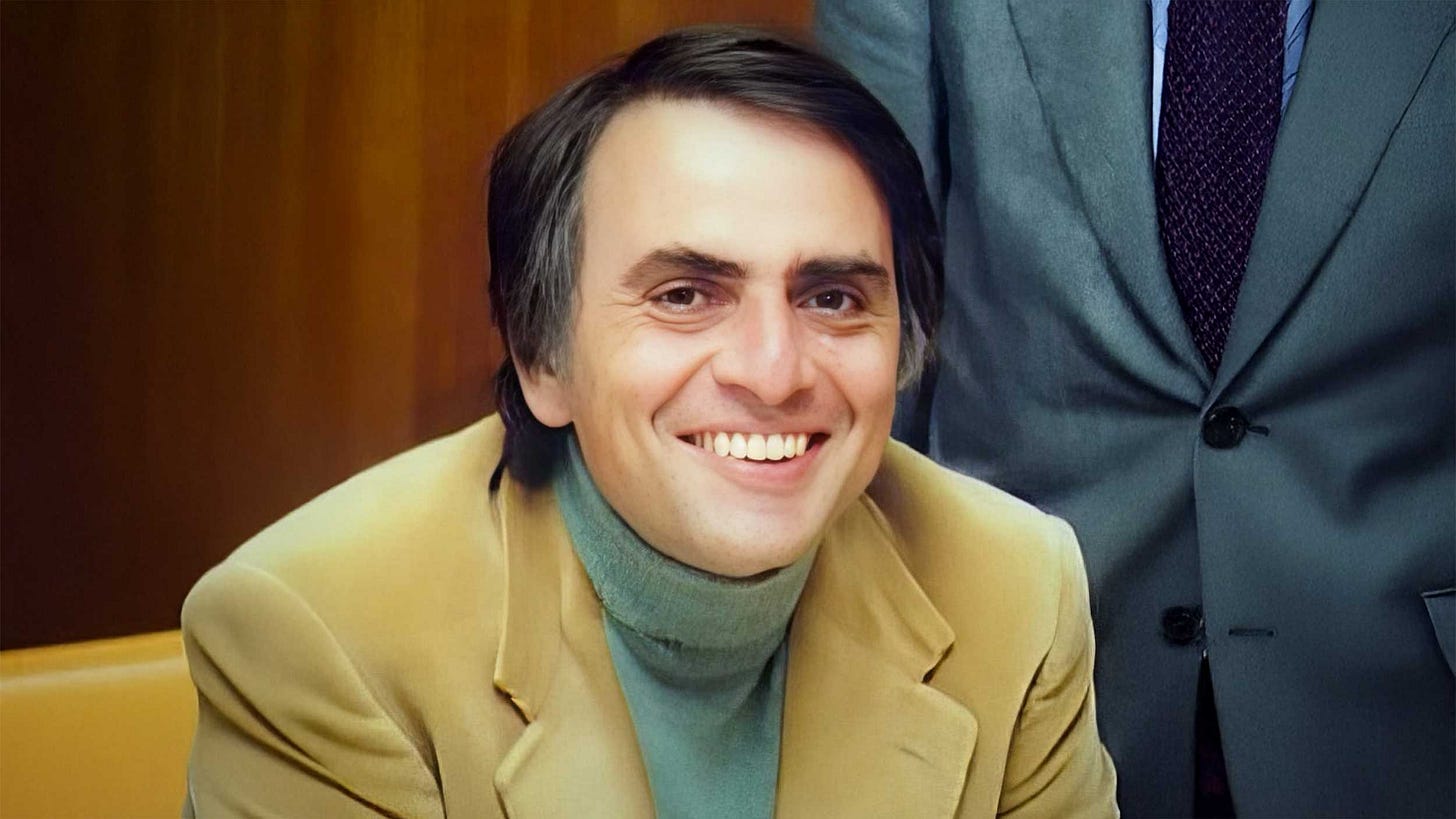The Cosmic Legacy of Carl Sagan
How one visionary astronomer brought the cosmos and science closer to us all.
"We are made of star stuff." With these simple yet profound words, Carl Sagan—astronomer, writer, and science communicator—invited millions to see themselves as part of the vast universe. As we mark what would have been his 90th birthday on November 9, 2024, it’s a fitting time to reflect on the man who changed how we understand our place in the cosmos. Through the groundbreaking television series Cosmos: A Personal Voyage (1980), scored by the iconic Vangelis, Sagan’s poetic and precise storytelling reached over half a billion viewers—an extraordinary feat for a science program.
In an era when the wonders of the universe often felt out of reach, Sagan’s calm, captivating voice brought the stars closer. Though his life was tragically cut short in 1996 by a rare bone marrow disease, his legacy endures in his books, his television work, and, most profoundly, in the countless minds he inspired to explore the mysteries of existence.
The Wonder of a Curious Mind
Sagan’s immense passion for science and space began in his childhood, as he gazed at the stars from Brooklyn and wondered about their origins. When he first asked his mother how stars were made, she sent him to the library to find a suitable book on the topic. To his surprise, the librarian handed him a book about Hollywood stars, misunderstanding the context of his question. This anecdote, which he often shared later, highlights not only his early interest in astronomy but also the importance of clear communication and understanding context when sharing information.
Because Sagan understood the need to communicate science in a way that would engage and resonate with his audience, he honed a unique talent for making complex scientific concepts accessible and comprehensible. As a young professor of astronomy, he became a regular guest on late-night talk shows, such as The Tonight Show Starring Johnny Carson. There, he discussed astronomy, space exploration, and the search for extraterrestrial life in an entertaining and understandable way. His appearances were hugely popular, helping to bring science into the mainstream.
Shaped by Family and Scientific Curiosity
Carl Sagan was born in 1934 in Brooklyn, New York, into a family of Jewish immigrants who had left Eastern Europe in search of a better life. His father, Samuel Sagan, worked various jobs to support the family, while his mother, Rachel Molly Gruber, was a homemaker. In many immigrant families of that era, intellectual pursuits were held in high regard, and education was seen as a key to success—a belief that would profoundly shape Sagan’s future.
Rachel, in particular, played a crucial role in nurturing Carl’s curiosity. Known for her sharp mind and ambition, she fostered a love of learning in her son from a young age. Despite the family's modest means, she encouraged him to explore his interests, even allowing him to conduct simple experiments at home. Her unwavering support and encouragement helped lay the foundation for Sagan’s boundless enthusiasm for science and his lifelong quest for knowledge.
The Personal Life of a Public Scientist
After completing his studies in physics and earning a Ph.D. in astronomy, Sagan quickly established himself as a rising star in the scientific community, collaborating with leading researchers across the United States. While his groundbreaking work in planetary science garnered attention, his personal life was equally intertwined with the scientific world.
Early in his career, he married biologist Lynn Margulis, known for her revolutionary theory of endosymbiosis, which explains the origin of eukaryotic cells. Although they shared a passion for science and had two children, their marriage ended relatively soon. Sagan later married twice more, including his final and longest partnership with writer Ann Druyan, who co-created the Cosmos series.
From Venus to the Greenhouse Effect
As a young astronomer in the early 1960s, Sagan hypothesized that the extreme surface temperatures of Venus were due to the greenhouse effect. He suggested that Venus’s thick atmosphere, composed mostly of carbon dioxide, trapped heat and led to the planet's scorching temperatures. This hypothesis was later confirmed by a space probe sent to Venus.
Sagan’s idea highlighted the importance of the greenhouse effect in shaping planetary climates and spurred research into the impact of greenhouse gases on Earth. He warned that unchecked increases in greenhouse gases on our planet could lead to a similar outcome as seen on Venus, with potentially catastrophic consequences for Earth.
In December 1985, Sagan testified before the U.S. Congress about the greenhouse effect and its potential impact on Earth’s climate. He emphasized that rising greenhouse gas concentrations could lead to global warming and climate change. He urged timely action, cautioning that failure to address the issue could create severe problems for future generations.
The Pale Blue Dot: A Vision for Humanity
Sagan participated in numerous NASA missions, including the Mariner, Viking, and Voyager probes. His vision led to the creation of the "Golden Record," a message to potential extraterrestrial civilizations carried aboard the Voyager spacecraft, containing sounds and images from Earth. One of his most notable achievements was the "Pale Blue Dot" photograph, which shows Earth as a tiny speck in the vastness of space.
As early as 1981, Sagan suggested that Voyager 1, once far enough from Earth, should turn its camera back to take a photograph of our planet. Initially, the idea faced strong opposition, as many experts deemed the photo unnecessary since Earth was already well-documented. Nevertheless, Sagan persisted, understanding the profound significance such an image could hold for humanity.
On February 14, 1990, when Voyager was already 6 billion kilometers away from Earth, the probe received the command to turn and take a "family portrait" of the Solar System. The resulting image shows Earth as nothing more than a faint blue dot. Sagan famously wrote about this photograph: “Look again at that dot. That’s here. That’s home. That’s us. On it, everyone you love, everyone you know, everyone you’ve ever heard of, every human being who ever was, lived out their lives.” The photograph has become a symbol of our place in the universe and a reminder of how precious our planet is.
Communicating Science with Heart and Precision
Sagan had a unique ability to present science in a way that was neither overly academic nor strictly technical, a pioneering approach at the time that has since become more widely accepted. His emotional connection to knowledge and enthusiasm for scientific discovery were key in sparking public interest. Such an approach is often a prerequisite for effectively conveying the significance and meaning of science.
In his television series Cosmos, Sagan employed a narrative style that took viewers on a journey through space and time. Rather than presenting dry facts, he used metaphors and storytelling to make complex scientific concepts accessible to a broad audience. For instance, he illustrated the age of the universe using the "cosmic calendar," compressing the entire history of the universe into a single year, effectively conveying vast timescales.
The Sagan Effect: The Price of Popularizing Science
Remembering Sagan also brings to mind the so-called "Sagan Effect," which refers to the phenomenon where scientists active in popularizing science face criticism or a diminished reputation within the academic community. The perception is that dedicating time and effort to communicating science to the public detracts from their seriousness or commitment to "real" science. Sagan himself faced many criticisms for his public outreach; he was denied tenure at Harvard and was not elected to the National Academy of Sciences, leading to this effect being named after him.
Today, the “Sagan Effect” has taken on a new dimension. While some still view public outreach with skepticism, the legacy of scientists like Sagan has paved the way for a new generation of science communicators who recognize that engaging the public is an essential part of the scientific mission.
In an era when the future of our planet seems uncertain, Sagan's message remains as relevant as ever: We are all stewards of this tiny, fragile world, and it is up to us to protect our shared home. As we continue to explore the cosmos and grapple with the challenges facing our planet, Sagan’s words remind us of our shared humanity and the fragile beauty of the only home we’ve ever known.






